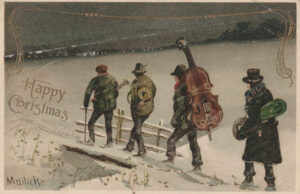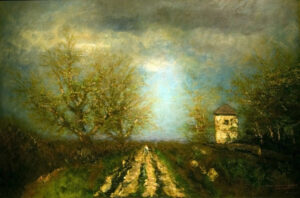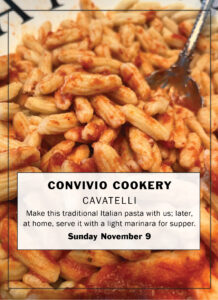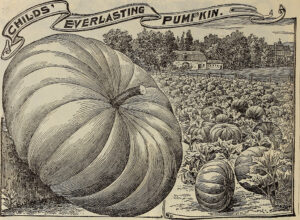There’s a book I have picked up and begun and lost twice in the last five years: Under the Greenwood Tree by Thomas Hardy. Both times I have read the opening chapter, which is set at Christmas (“Part the First: Winter”), and then perhaps some of the next chapter, and then something important comes up and I set the book down in a very logical place and eventually I forget the logic behind that particular decision. The book remains unfinished to this day. Be that as it may, I’ve just found it again. It is, I think, an early 20th century printing (undated, part of the Sun Dial Library by the Garden City Publishing Company) bound in green buckram, a small book. I think it’s the perfect book to reopen now. I’ll begin at that same Christmastime chapter, but the plan this time is to not set it aside once I move on to the following chapters. I’m going to read the story through and through this time, and then, perhaps, it may be Christmastime in my own life, too, and not just for the folks who make up the Mellstock Church West Gallery Choir.
In his BBC Radio program from 2014, A Cause for Caroling, Jeremy Summerly laments the passing of the West Gallery Choirs, like the Mellstock Church Choir, from English churches. The sound was heartfelt, real, not polished… pure joy. By the late 19th century, the Victorians had effectively replaced the west gallery choirs with organs and proper choirs who sang proper arrangements of proper carols. And I do love a choir like that (don’t you?), but I also feel, like Jeremy Summerly, a sense of loss: that perhaps we may have lost something of the passion that was more prevalent in the Mellstock Church Choir, with its strings and woodwinds and brass and less polished sound.
This all brings us to your Convivio Book of Days calendar for December. Our cover star this month is an old penny postcard by Alfred Moritz Mailick, printed around 1902, who, if you ask me, was just as wistful for the west gallery choirs that had, by then, gone by the wayside. Click to see it: four musicians are bundled up, trudging through the snow, on their way to town (to the church, no doubt, for Midnight Mass). One has a trumpet, one a French horn, another a cello, and the one bringing up the rear has, I think, a violin in a green case. I see this image and I immediately think of Dick Dewy and his father, Rueben, and the other country folk that make up the Mellstock Church Choir. I may be wrong, colored by the fact that I have just found my lost book again… but I don’t think I am.
And so here we are: Advent has begun and we are now on our approach to Christmas. These weeks ahead of Christmas Eve and Christmas Day are designed to help us prepare the way: a time of darkness that leads us to the light of Christmas. It is a time to make our homes as fair as we are able. On the Sunday evening that just passed, we lit one purple candle in our Advent wreath of three purple candles and one rose candle. The first candle, representing Hope. When Sunday comes again this weekend, we will light two purple candles in that ring, the second representing Peace. On the third Sunday, a day known as Gaudete Sunday, we will light the two purple candles we’ve lit before, plus the rose candle. The rose candle represents Joy. And on the fourth and final Sunday of Advent, we will light all four candles, the last purple candle in the ring representing Love. That also happens to be, this year, the day of the Midwinter Solstice, and on that darkest, deepest night of the year, our Advent wreath will shine brightest. Brightest and Best. Like an old carol sung by a west gallery choir.
COME SEE US!
We’ve got several pop-up markets planned these next few weeks and we’d love to see you if you’re local!
Saturday December 6, Miami
MIAMI CHRISTMAS MARKET
We’ll have a huge pop-up shop filled with handmade artisan goods from Germany plus specialty foods, too, and our Advent candles and calendars. Saturday December 6 from 11 AM to 8 PM, indoors and outdoors (we’ll be indoors) at the German American Social Club in Miami, which is where we spent Oktoberfest this year. 11919 SW 56th Street, Miami.
Friday December 12, Lake Worth
KRAMPUSNACHT
On the Eve of St. Nicholas’ Day, it is Krampus who accompanies the good saint to scare girls and boys into good behavior, and he gets his own celebration at the American German Club in suburban Lake Worth (a little later than St. Nicholas’ Eve) on Friday evening, December 12, from 6 to 11 PM. We’ll be there with our biggest pop-up shop ever as this night ushers in the weekend’s Christkindlmarkt. Tickets required and must be purchased in advance. 5111 Lantana Road, Lake Worth.
Saturday & Sunday, December 13 & 14, Lake Worth
CHRISTKINDLMARKT
The annual Christkindlmarkt at the American German Club in suburban Lake Worth is just wonderful, and we’ll be there with our biggest pop-up shop ever, filled with German Christmas artisan goods plus more from Sweden and Mexico, as well as specialty foods and who knows what else! Tickets are required and must be purchased in advance. Usually sells out! Saturday December 13 from 1 to 9 PM and Sunday December 14 from 11 AM to 7 PM. 5111 Lantana Road, Lake Worth.
Friday Evening December 19 and Saturday & Sunday December 20 & 21
SOLSTICE MARKET at the shop
We don’t keep regular hours at the shop, but we do open for special events, and this is our next one. Festive shopping, good music, good company, homemade Christmas cookies while you shop with our own Löfbergs Coffee from Sweden… and your last chance to pick up Christmas items from us before the Yuletide Season begins, as we won’t be open again until January (though we will open for you by appointment, should you need us). Our Solstice Market is on Friday evening December 19 from 6 to 9 PM and on Saturday & Sunday, December 20 & 21, from 11 AM to 4 PM.
Image: “Happy Christmas,” printed postcard by Alfred Moritz Mailick, circa 1902. [Public domain] via Wikimedia Commons. A note, too, on the “Brightest and Best” (also called “Star in the East”) video above: Jeremy Summerly, in his A Cause for Caroling BBC Radio program mentioned earlier, makes the argument that “Christmas has always had one foot in the church and one in the pub.” I think this is readily observed in the performance of this old carol.




